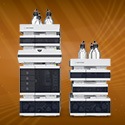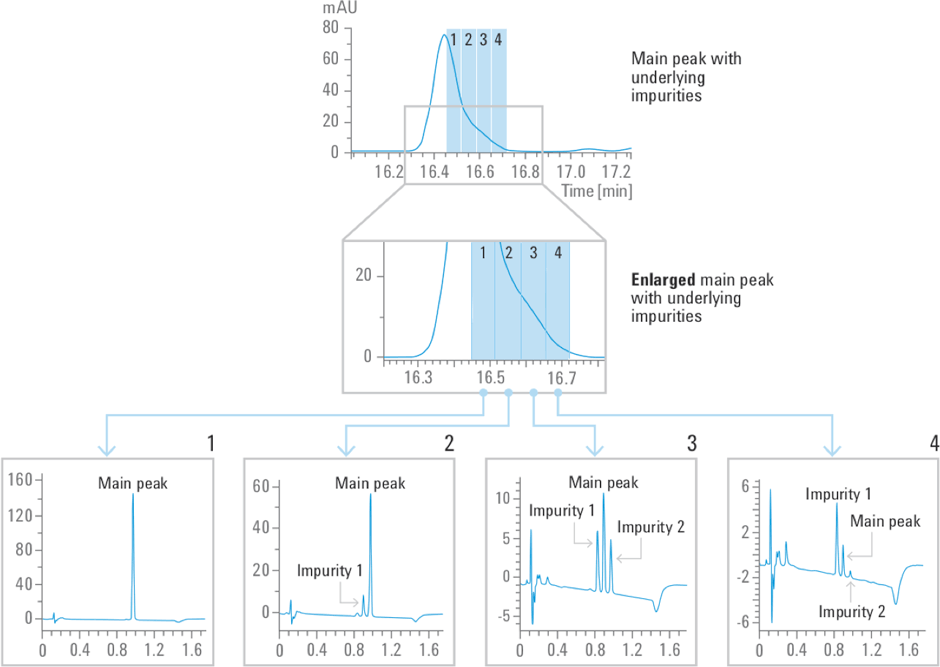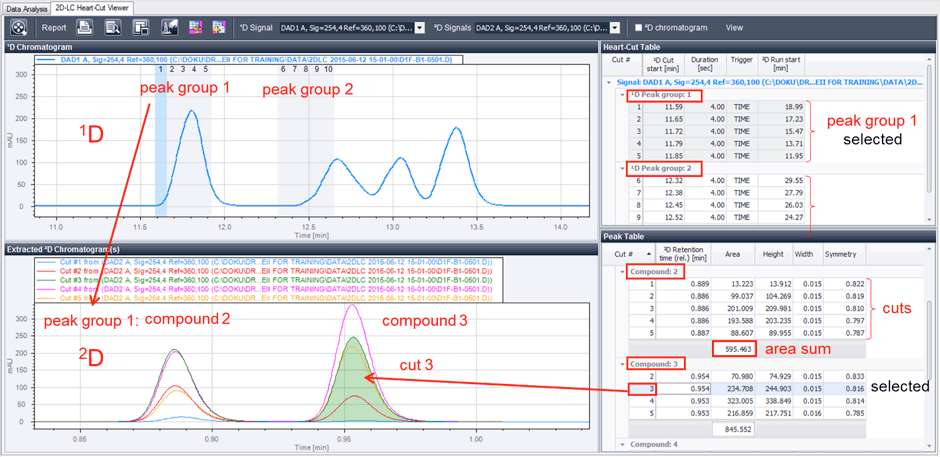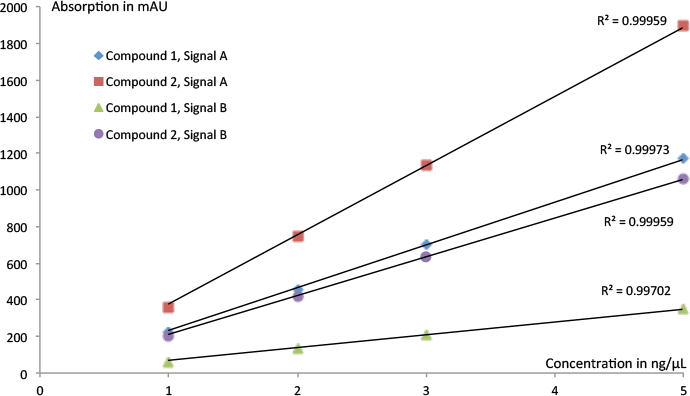Access Agilent eNewsletter March 2016

Evolution of multiple heart-cutting 2D-LC:
Agilent 1290 Infinity II provides high-resolution sampling and easy quantitation
Ulrich Eberhardinger and Jens Trafkowski, Agilent Product Managers, Liquid Phase Separations Business
Multiple heart-cutting 2D-LC has become a valuable tool for the analysis of medium to highly complex samples. This technique applies two different separation mechanisms to improve resolution and peak capacity. But many scientists want to extend the possibilities of 2D-LC—to analyze broad peaks and to achieve the optimum resolution in both dimensions. High-resolution sampling is the solution.
High-resolution sampling provides advantages of both 2D-LC techniques
Until now, scientists needed to choose from two complementary 2D-LC modes: heart-cutting and comprehensive 2D.
Heart-cutting 2D-LC allows detailed analysis of short cuts made in the first dimension and uses long gradients to achieve the highest resolution in the second dimension. Multiple heart-cutting 2D-LC adds the possibility to store several peaks and decouples run times in the second dimension from those in the first dimension. This technique enables the analysis of samples with more compounds of interest than single heart-cutting 2D-LC.
Comprehensive 2D-LC transfers the entire effluent from the first to the second dimension. It is most useful for the analysis of highly complex or unknown samples with a large number of areas of interest in the first dimension. The entire 2D analysis time of typically 20 to 40 seconds, including column re-equilibration, is equal to the time used to store cuts in the first dimension. Therefore, this technique requires both fast gradients in the second dimension and relatively long cuts in the first dimension. This dependency limits the resolution in both dimensions:
- Compounds that may already have been separated in the first dimension are stored and remixed in a sample loop and then transferred to the second dimension, which results in an undersampling effect. [1]
- Fast gradients in the second dimension may not allow you to achieve the best possible 2D resolution.

Figure 1. High-resolution sampling enables good separation of the two low-concentration impurities next to the big main peak.
Excellent resolution in both dimensions
High-resolution sampling combines advantages of both heart-cutting and comprehensive 2D-LC. Up to 10 consecutive cuts can be defined for the first dimension, and they are stored the same as those for multiple heart-cutting. Cuts can be set up easily and flexibly in the Agilent 2D-LC software.
High-resolution sampling enables the analysis of larger areas of interest or broad unresolved peaks in the first dimension (Figure 1). It can use small cuts down to about 3 µL, which corresponds to cut lengths below 1 second retention time difference (depending on the 1D flow rate). Unlike comprehensive 2D-LC measurements, it retains the resolution gained in the first dimension and allows long runs in the second dimension.
Better than a single large sample loop
Alternatively, 2D-LC users have cut large peaks in a single large loop instead of multiple small sample loops. Large sample loops have several disadvantages:
- A high-volume sample loop sacrifices the 1D resolution, due to undersampling. [1]
- A large sample volume transferred to the second dimension may overload the 2D column.
- Transfer of large volumes of solvent with high elution strength can negatively impact the separation in the second dimension.
Therefore, high-resolution sampling is a much more powerful choice than increased sample loop size.

Figure 2. Quantitative data analysis of multiple cut samples uses peak grouping and area summing.

Figure 3. High-resolution sampling 2D-LC provides excellent linearity at two wavelengths for a calibration with two compounds in the Agilent 2D-LC checkout sample.
Reliable quantitation via summed peak areas
High-resolution sampling also delivers precise and reproducible 2D-LC quantitation because the entire sample volume for a peak is transferred to the second dimension. Because the peak is split up into several cuts, the Agilent 2D-LC software automatically groups consecutive cuts and sums peak areas of all compounds with similar retention times in the second dimension (Figure 2). The result is very reliable quantitation using summed areas. [2] See Table 1 as an example.
| Compound | 1 | 2 | 3 | 4 | 5 |
|---|---|---|---|---|---|
| RSD% | 2.8% | 1.9% | 1.6% | 1.6% | 0.5% |
Table 1. Excellent area reproducibility for 20 consecutive runs of compounds in the checkout sample.
As shown in Figure 3, the calibrations that result from these 2D-LC measurements exhibit very good linearity, usually with a correlation (R2) greater than 0.999 for resolved peaks.
The new Agilent 1290 Infinity II 2D-LC with Multiple Heart-Cutting offers a complete solution that includes ready-to-go hardware and comprehensive software for easy method setup, rapid qualitative data evaluation, and smooth quantitative data analysis. With this solution, 2D-LC becomes even easier to use, provides greater performance, and is accessible for every analytical chemist.
Agilent delivers a full system checkout and dedicated 2D-LC training to ensure your success as you optimize your LC separation.
For additional information, watch this video about the new Agilent 1290 Infinity II 2D-LC Solution with Multiple Heart-Cutting.
References
- Davis, J.M., Stoll, D.R., Carr, P.W., Effect of First-Dimension Undersampling on Effective Peak Capacity in Comprehensive Two-Dimensional Separations, Anal. Chem., 2008, 80, 461-473, doi: 10.1021/ac071504j.
- Buckenmaier, S., Agilent 1290 Infinity 2D-LC Solution for Multiple Heart-Cutting, Agilent Technical Overview 5991-5615EN.
Stay informed about the applications that are important to you
Subscribe to Access Agilent
Our free customized
monthly eNewsletter
Article Directory – March 2016
All articles in this issue
 Evolution of multiple heart-cutting 2D-LC: Agilent 1290 Infinity II provides high-resolution sampling and easy quantitation
Evolution of multiple heart-cutting 2D-LC: Agilent 1290 Infinity II provides high-resolution sampling and easy quantitation Tip: How to achieve efficient, effortless LC method transfer to the Agilent 1290 Infinity II LC System
Tip: How to achieve efficient, effortless LC method transfer to the Agilent 1290 Infinity II LC System Agilent 1290 Infinity II RID delivers high resolution and rapid polymer characterization
Agilent 1290 Infinity II RID delivers high resolution and rapid polymer characterization Dual-needle option for LC autosamplers provides improved speed, flexibility, and accuracy
Dual-needle option for LC autosamplers provides improved speed, flexibility, and accuracy Multiple heart-cutting 2D-LC/MS method for reproducible resolution of chiral drug metabolites
Multiple heart-cutting 2D-LC/MS method for reproducible resolution of chiral drug metabolites Quick, accurate screening for suspect environmental contaminants with Agilent solutions
Quick, accurate screening for suspect environmental contaminants with Agilent solutions
Figure 1

High-resolution sampling enables good separation of the two low-concentration impurities next to the big main peak.
Figure 2

Quantitative data analysis of multiple cut samples uses peak grouping and area summing.
Figure 3

High-resolution sampling 2D-LC provides excellent linearity at two wavelengths for a calibration with two compounds in the Agilent 2D-LC checkout sample.